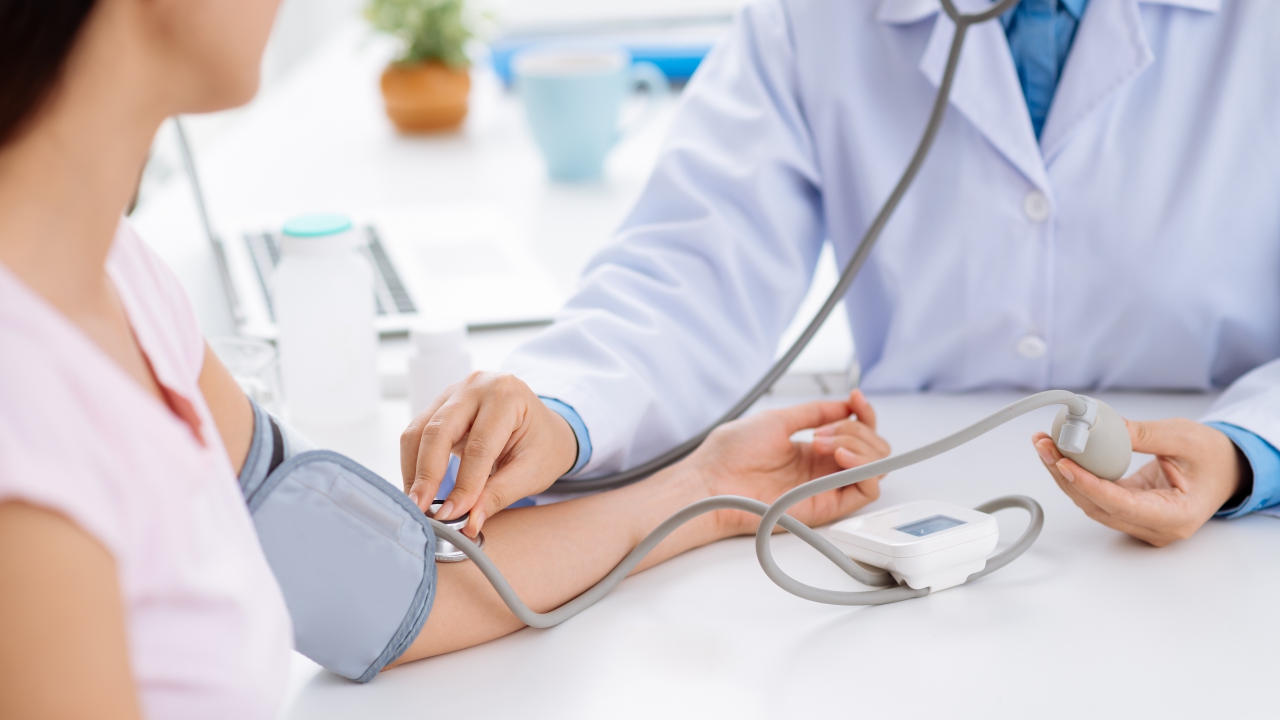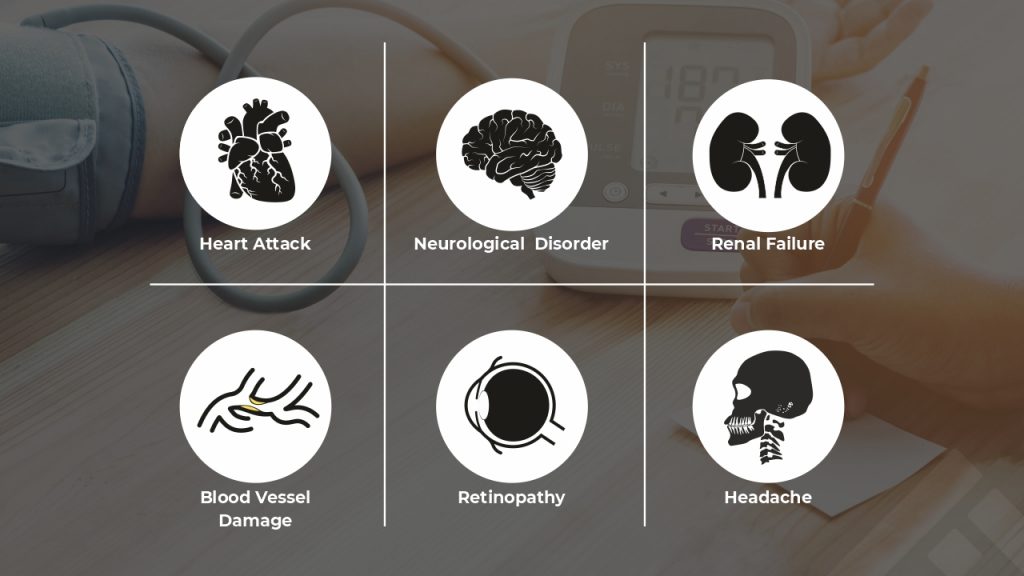
Hypertension: When Did You Last Check Your Blood Pressure?

Some diseases are asymptomatic. They don’t have any outward signs or symptoms that can help in diagnosing them. Hypertension or high blood pressure is one such condition, and is also called the “silent killer”.
Symptoms of hypertension are often confused with other diseases and disregarded as stress, tiredness, or age-related vision disturbance. By the time it is detected, it has already caused a lot of damage to the body. Hence, it’s in your best interest to get your blood pressure (BP) checked regularly.
What happens in hypertension?
Your circulatory system is like a closed water pump unit. The heart is the pump here, with blood vessels acting as pipes to carry blood to various parts of your body. In hypertension, the high pressure of the blood severely damages the walls of the heart, blood vessels, and other organs. Chronic (long-term) high blood pressure rapidly increases the workload of the circulatory system, leading the left chamber of your heart to grow in size to compensate for it. Eventually, this chamber gets exhausted and fails. Raised BP accounts for 10.4 million deaths globally every year.

Why can’t your body control high blood pressure?
The human body has a lot of resilience and self-healing mechanisms. When the blood pressure starts rising due to any reason, the heart, blood vessels and kidneys work hard to control it. The heart enlarges and the kidney tries to remove more salt and water from the body to lower the volume of fluid in the blood. The blood vessels change their diameter to accommodate the increased blood volume flowing at high pressure.
You actually start experiencing symptoms only after the body has utilized all its self-correcting mechanisms. And by the time you seek help, a lot of irreversible damage has already taken place. All a physician can do is prevent further damage to the body.
What are the some of the symptoms?
There are no symptoms in the early stages, but some tell-tale signs to look out for are:
- Headache
- Blurring of vision
- Anxiety
- Nosebleed
- Shortness of breath
- Excessive or reduced amount of urine
- Stroke
How do you measure blood pressure?
An instrument called the sphygmomanometer is used to measure blood pressure. It has a cuff, which is tied to the upper arm. There are also two tubes, one for increasing the pressure in the cuff and the other to connect the cuff to the instrument.
Blood pressure is expressed as a fraction, for eg, 120/80mm of Hg or 140/90mm of Hg. The first number or the numerator stands for systolic blood pressure, which is the pressure in the arteries when the heart pumps blood into them. The second number or the denominator is called the diastolic pressure. It refers to the pressure of blood inside arteries when the heart is relaxing between the beats. Technically, diastolic pressure also reflects the pressure inside the heart after blood has been pumped out into the arterial system. This makes the diastolic reading more significant because it indicates the load on the heart even when it is not working.
If your blood pressure fluctuates a lot throughout the day, or if your condition is critical, invasive blood pressure monitoring may be required. It involves inserting a cannula into an artery to get a direct reading of the blood pressure. Though it is the most accurate BP-reading technique, it is not used routinely as it is invasive.
Normal BP readings
The Joint National Committee (JNC) is the international body, which sets and updates the guidelines and treatment strategies for hypertension on a regular basis. The normal ranges of blood pressure are different for different age groups.
As per the latest guidelines, a BP less than 120/80 mm of Hg is considered normal in adults, while readings up to 139/89 mm of Hg is considered to be indicative of pre-hypertension
Till this stage, the blood pressure can be controlled by lifestyle changes if the individual has no other disease. A reading above 140/90mm of Hg warrants a detailed examination, blood tests, and specific tests related to heart and blood vessels. The treatment takes into account age, lifestyle, and the amount of damage to various organs.
Causes of hypertension
In 90% to 95% of cases, no specific causes can be found and are called essential or primary hypertension. It is common in adults, especially those above the age of 40. In the remaining 5%-10% cases, hypertension occurs due to identifiable and often, controllable medical conditions such as kidney, adrenal glands, or liver diseases. Secondary hypertension is common in children and young adults.
Also read: Yoga: Common Contraindications You Should Know
Risk factors of hypertension
Though there are no identifiable causes of primary hypertension, there are certain risk factors that might make you vulnerable to it.
- Being overweight or obese
- Inactivity or sedentary lifestyle
- High salt intake in the diet
- Smoking
- Alcohol consumption
- High-stress levels
- Other lifestyle diseases like diabetes
- Family history of hypertension
- Age — hypertension, along with other heart problems, is more common in men above 40 and women after menopause
How do you prevent hypertension?
Primary hypertension is classified as a lifestyle disease and can be prevented by making changes to your daily routine. Regular exercise and a balanced diet can go a long way to keep it at bay.
Exercise: All kinds of household chores, as well as activities such as climbing stairs and gardening, can help improve the capacity of the heart and blood flow in the arteries. Aerobic exercises, cardio workouts, walking, swimming, and jogging are also beneficial. You should get at least 30 minutes of physical activity on most days of the week. Around 150 minutes of moderate physical activity or 75 minutes of vigorous physical activity per week is highly recommended.
Diet: A balanced diet, low on salt and sugar, is the mainstay for any lifestyle disease. However, diets that are particularly useful in maintaining an ideal weight and blood pressure are:
Dietary Approaches to Stop Hypertension (DASH) diet: Widely recommended by physicians around the world, the DASH diet is rich in fruits, vegetables, whole grains, and low-fat dairy foods. It includes meat, fish, poultry, nuts, and beans, and limits sugar/ sweetened foods and beverages, red meat, and added fats. This diet is a well-balanced eating approach in general.
Mediterranean diet: This includes high proportions of olive oil, legumes, unrefined cereals, fruits, and vegetables, moderate to high consumption of fish, moderate consumption of dairy products, and low consumption of non-fish meat products. According to various studies, olive oil reduces the risk of many chronic diseases.
Low salt diet: Salt reduction, restricted to a maximum of 5g, is highly beneficial in reducing the risk of hypertension and other heart diseases. The American Heart Association has recommended an even lesser salt intake of up to 1.5 gm. However, such low sodium intake can be problematic for athletes or if you are on certain medicines. Consult a dietician before you make any dietary changes.
Weight loss: Weight loss — even as little as 5%–10% of current body weight — reduces the risk of hypertension significantly.
Stress management: Meditation and breathing exercises help activate the parasympathetic system, reducing the stress hormone in the body. A balanced diet, adequate sleep, and healthy relationships also contribute to your mental wellbeing and overall health.
Lifestyle changes: Not smoking and drinking can help prevent hypertension.
Regular medical check-up: A blood pressure check-up is recommended at least once a year if you are healthy. If you suffer from any lifestyle disease, get it checked every six months.
How can you manage hypertension?
If you have been diagnosed with hypertension, following medical advice is mandatory. Your medicines can increase your urine output to remove excess sodium from your body, dilate your blood vessels, and reduce the pace of your heartbeats, thereby decreasing blood pressure. Some other measures are:
Becoming more physically active is vital. A healthier heart takes less effort to pump more blood, and exercise improves its capacity to do so
It also significantly reduces both systolic and diastolic BP as an immediate effect, which lasts almost 24 hours post-exercise. It can also help you manage weight, which is a risk factor for hypertension. Aerobic activities, like climbing stairs, swimming, or even dancing thrice a week for at least 30 minutes, are beneficial.
Eat a balanced diet. Reducing sodium intake to 1,500mg is the quickest way to manage and lower blood pressure. Limit intake of saturated fats and eliminate trans fats. Instead, consume potassium-rich foods like bananas, green leafy vegetables, and beans, which improve your electrolyte balance. Dehydration can cause fluctuations in your blood pressure, so remember to drink at least eight glasses of water a day.
Avoid alcohol or smoking as a response to stress. Instead, you can exercise, or do yoga and meditation to release happy hormones. Seek therapy if required.
Can medication for hypertension be stopped?
Many people stop taking medication for hypertension when they start feeling better or when BP readings lower to normal levels. That’s a mistake. It is advisable to never stop or reduce medication without medical advice. Hypertension is a lifelong disease. Once medicines are stopped, it will bounce back with more vigor and cause more damage.
Hypertension can be managed, if not prevented, with the help of healthy lifestyle choices, a nutritious diet, adequate physical activity, stress management, regular checkups, and medication. Be vigilant and take care of your heart.
References
1. Hegde SM, Solomon SD. Influence of Physical Activity on Hypertension and Cardiac Structure and Function. Curr Hypertens Rep 2015; 17: 77.
2. Nystoriak MA, Bhatnagar A. Cardiovascular Effects and Benefits of Exercise. Front Cardiovasc Med 2018; 5: 135.
3. Unger T, Borghi C, Charchar F, et al. 2020 International Society of Hypertension Global Hypertension Practice Guidelines. Hypertension 2020; 75: 1334–57.
4. 2015-2020 Dietary Guidelines. Health.gov. https://health.gov/our-work/food-nutrition/previous-dietary-guidelines/2015 (accessed Mar 2, 2021).
5. High blood pressure (hypertension). MayoClinic. https://www.mayoclinic.org/diseases-conditions/high-blood-pressure/symptoms-causes/syc-20373410 (accessed Mar 2, 2021).
6. Hypertension. World Health Organization. https://www.who.int/health-topics/hypertension#tab=tab_1 (accessed Mar 2, 2021).














